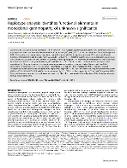Haplotype analysis identifies functional elements in monoclonal gammopathy of unknown significance

Author
Thomsen, Hauke
Chattopadhyay, Subhayan
Weinhold, Niels
Hoffmann, Per
Nöthen, Markus M
Jöckel, Karl-Heinz
Schmidt, Börge
Hajek, Roman
Hallmans, Göran
Pettersson-Kymmer, Ulrika
Späth, Florentin
Goldschmidt, Hartmut
Försti, Asta
Publication date
2024Published in
Blood Cancer JournalVolume / Issue
14 (1)ISBN / ISSN
ISSN: 2044-5385ISBN / ISSN
eISSN: 2044-5385Metadata
Show full item recordCollections
This publication has a published version with DOI 10.1038/s41408-024-01121-8
Abstract
Genome-wide association studies (GWASs) based on common single nucleotide polymorphisms (SNPs) have identified several loci associated with the risk of monoclonal gammopathy of unknown significance (MGUS), a precursor condition for multiple myeloma (MM). We hypothesized that analyzing haplotypes might be more useful than analyzing individual SNPs, as it could identify functional chromosomal units that collectively contribute to MGUS risk. To test this hypothesis, we used data from our previous GWAS on 992 MGUS cases and 2910 controls from three European populations. We identified 23 haplotypes that were associated with the risk of MGUS at the genome-wide significance level (p < 5 x 10(-8)) and showed consistent results among all three populations. In 10 genomic regions, strong promoter, enhancer and regulatory element-related histone marks and their connections to target genes as well as genome segmentation data supported the importance of these regions in MGUS susceptibility. Several associated haplotypes affected pathways important for MM cell survival such as ubiquitin-proteasome system (RNF186, OTUD3), PI3K/AKT/mTOR (HINT3), innate immunity (SEC14L1, ZBP1), cell death regulation (BID) and NOTCH signaling (RBPJ). These pathways are important current therapeutic targets for MM, which may highlight the advantage of the haplotype approach homing to functional units.
Keywords
Humans, Monoclonal Gammopathy of Undetermined Significance/genetics, Haplotypes, Genome-Wide Association Study, Polymorphism, Single Nucleotide, Genetic Predisposition to Disease, Male, Female, Multiple Myeloma/genetics
Permanent link
https://hdl.handle.net/20.500.14178/2683License
Full text of this result is licensed under: Creative Commons Uveďte původ 4.0 International







